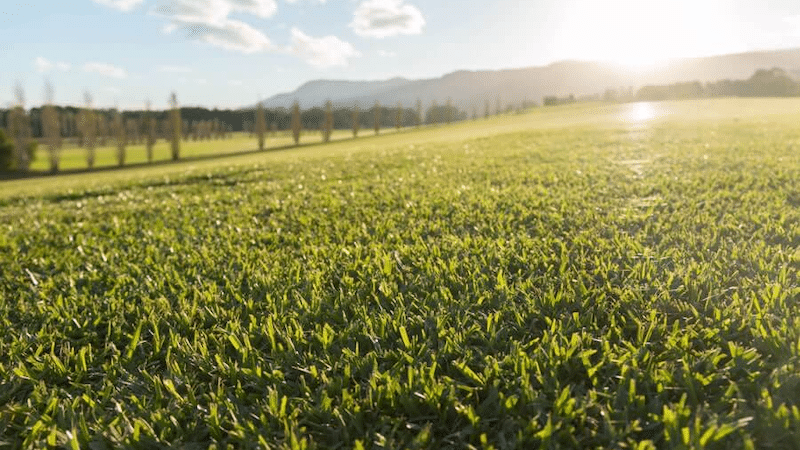
- Categories: LAWN CARE
Sir Walter Turf Laying Tips
Congratulations, you’ve chosen a fantastic turf variety in Sir Walter Buffalo; it’ll keep its lush, green looks throughout the year.
It has excellent drought tolerance and wear resistance and will cope with a wide range of weather conditions.
Your next critical step is to make sure you lay your turf following best practices to keep it looking its best.
Follow these helpful tips for laying turf and you’ll have a stunning lawn in no time.
How To Lay
Try to lay your new turf as soon as it is delivered. The soil should be moderately moist before you start laying turf.
Roll out turf starting from the longest straight edge. Butt all joins tightly together with no overlapping.
Lay turf in a brickwork pattern to reduce water erosion especially on steep slopes and grades. Lay rolls across slopes rather than down.
Smooth out any air pockets in the turf by rolling or tamping to ensure that there is good contact between the roots of the turf and the soil.
Fill joins and level any depressions with a light dressing of washed river sand or turf underlay. Water your new lawn immediately after it has been laid.
Give it a really good soak initially and then depending on the weather keep the surface from drying out by watering each morning and maybe up to four times per day in hot conditions.
How To Prepare For Laying Sir Walter
Soil preparation is vital. Start by making sure the soil quality in the area where you plan to lay the turf is of sufficient quality and depth.
- Clear out any existing lawn, rocks and weeds. You may need to spray first a number of weeks before laying to kill the existing grass or weeds.
- Rotary hoe the soil, removing any rocks or debris that come to the surface.
- Test pH levels and modify until soil pH is around 7.
- Apply pre-lawn fertilizer and rake in.
- Grade and level the soil surface for a smooth result.
What’s The Best Time To Lay Sir Walter?
That depends on a range of factors. In theory you can install turf throughout the year in most parts of Australia but the cooler months will slow down the establishment of the new turf and hot conditions will require more frequent watering times to keep the new turf from drying out.
But if your lawn is likely to experience adverse conditions like drought or really hot Summer days it may be advisable to delay laying your turf until a later date.
Low light, high rainfall, and frosts may make laying turf in the cold months a real challenge whereas drought and water restrictions could pose insurmountable barriers in the hotter months.
As a general rule, Spring and late Summer is usually the best time to put down new turf.
Laying Sir Walter Turf In Autumn
Even though Sir Walter is a warm season grass the decision to lay turf in winter can have some real advantages.
You won’t need to irrigate your new lawn as much as during the warmer months and you won’t have to mow your lawn until well into spring.
If you do lay turf in winter, keep in mind that the grass growth and root establishment phase will be very slow and prolonged. To protect your lawn you must keep off the grass.
Heavy traffic including pets, children or repeated walking will easily damage your new lawn in this delicate establishment period.
And remember just because it is cold doesn’t always mean that the soil and turf is moist enough to establish the new lawn.
Laying Sir Walter Turf In Spring
Autumn can be a great time to lay turf. Natural rainfall may help water your new lawn in and if it’s early enough in the season then the soil and ambient temperatures will still be high enough to get some root and grass growth going before the real cold sets in.
If you want to lay turf in late Autumn then you need to consider what conditions will be like through the colder months.
Whilst Sir Walter Buffalo has a very high shade tolerance and retains good winter colour you’ll need to keep traffic to a minimum on your new lawn until it is well established.
Laying Sir Walter Turf In Summer
Sufficient regular watering is the critical issue that you’ll face when laying Sir Walter Buffalo turf in Summer.
The turf underlay soil needs to be maintained in a constantly moist condition until the lawn has put down deep roots in the soil underneath and the leaves of the turf should get regular watering so that they don’t dry out in the heat.
If the leaves fold over and look grey then you need to shower the new lawn with water as soon as possible before the result is terminal.
If you allow the lawn to dry out during this phase then it will quickly die.
During periods of extreme heat you may need to water several times each day and this could be a problem with water restrictions during droughts unless you have an approved automatic watering system with rain or soil sensors.
When Do You Mow Sir Walter After Laying?
Your lawn can have its first mow when the roots have become established (usually around 14 days in warm conditions).
You can test this by trying to lift the turf. If you cannot lift the turf easily it’s a good sign that the roots have grown through the turf underlay soil and become firmly established.
Avoid mowing until grass blade length is around 60 to 70mm. Mow along the direction of the turf rolls until the turf is well established.
If you laid your turf in Winter you might be best to wait for the first mow until spring depending on growth rates.
But at no point should you remove more than a 3rd of the blade length and ensure that you don’t mow the lawn too low and scalp the grass as this will set it back further.
Watering Newly Laid Sir Walter Turf After Establishment
You need to water your lawn 2 or 3 times a week during Summer and once a week in Winter while the lawn is developing its root system.
Modify your watering regime as per weather conditions. Deep watering less often is better than more frequent light watering.
The best time to water is in the early morning to avoid excessive water loss through evaporation.
Fertilising Newly Laid Sir Walter Turf
Apply some fresh fertiliser about 2 weeks after you lay the turf. Slow-release lawn food such as Sir Walter fertiliser is generally a great choice.
Apply fertilizer every 8 weeks for the first 12 months to maintain a healthy lawn.
Oxafert is a good fertiliser with a mix of pre -emergent herbicide to use at the start of Autumn and Spring at the rate of 3 kg per 100 square metres.
This product will deter Summer and Winter grass weeds from invading your lawn and will fertilise it at the same time.
One of your regular fertilising applications can be dropped out if you use Oxafert.
How Much To Lay – What’s The Cost?
To work out much turf you’ll need, draw a plan of the area. If necessary, you’ll need to divide it up into rectangles, squares, triangles or circles.
Measure the actual areas in metres (m) and note these on your plan. Use the following methods to calculate the area of various shapes.
Rectangle: width multiplied by height = area.
Triangle: width multiplied by height and divide by 2.
Circle: diameter, divide it by 2 to get the radius, square that and multiply by pi (3.14).
Semi-circle: use the same method as for a circle, but halve the area.
Area of a semi-circle = 3.14 x the radius squared and divided by 2.
Adding together the various shapes will allow you to estimate reasonably accurately the total area of even very complex shaped lawns. Allow a little extra for errors.
Sir Walter Buffalo turf provides exceptional value at $15.95 per square metre.
We can usually have your turf delivered the next day if you get your order in before 10.00am.
Grech’s Turf Supplies – The Best Lawn
Grech’s Turf Supplies is an accredited Lawn Solutions Australia turf farm and supplier. We have a long established reputation for growing the best Sir Walter Buffalo around.
Our specialised trucks and forklifts provide safe contact less delivery of your quality turf for same day installation.
Talk to the friendly experts at Grech’s Turf today about turf varieties and how we can help you get the most beautiful lawn for your money.










